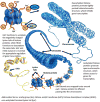Mechanisms and clinical significance of histone deacetylase inhibitors: epigenetic glioblastoma therapy
- PMID: 25667438
- PMCID: PMC6052863
Mechanisms and clinical significance of histone deacetylase inhibitors: epigenetic glioblastoma therapy
Abstract
Glioblastoma is the most common and deadliest of malignant primary brain tumors (Grade IV astrocytoma) in adults. Current standard treatments have been improving but patient prognosis still remains unacceptably devastating. Glioblastoma recurrence is linked to epigenetic mechanisms and cellular pathways. Thus, greater knowledge of the cellular, genetic and epigenetic origin of glioblastoma is the key for advancing glioblastoma treatment. One rapidly growing field of treatment, epigenetic modifiers; histone deacetylase inhibitors (HDACis), has now shown much promise for improving patient outcomes through regulation of the acetylation states of histone proteins (a form of epigenetic modulation) and other non-histone protein targets. HDAC inhibitors have been shown, in a pre-clinical setting, to be effective anticancer agents via multiple mechanisms, by up-regulating expression of tumor suppressor genes, inhibiting oncogenes, inhibiting tumor angiogenesis and up-regulating the immune system. There are many HDAC inhibitors that are currently in pre-clinical and clinical stages of investigation for various types of cancers. This review will explain the theory of epigenetic cancer therapy, identify HDAC inhibitors that are being investigated for glioblastoma therapy, explain the mechanisms of therapeutic effects as demonstrated by pre-clinical and clinical studies and describe the current status of development of these drugs as they pertain to glioblastoma therapy.
Keywords: Clinical trials; epigenetics; glioblastoma; histone deacetylase inhibitor; preclinical trials; review.
Copyright© 2015 International Institute of Anticancer Research (Dr. John G. Delinassios), All rights reserved.
Conflict of interest statement
No Author has a conflict of interest.
Figures
References
-
- Ahmad M, Hamid A, Hussain A, Majeed R, Qurishi Y, Bhat JA, Najar RA, Qazi AK, Zargar MA, Singh SK, Saxena AK. Understanding histone deacetylases in the cancer development and treatment: an epigenetic perspective of cancer chemotherapy. DNA Cell Biol. 2012;31(Suppl 1):S62–71. - PubMed
-
- Bezecny P. Histone deacetylase inhibitors in glioblastoma: pre-clinical and clinical experience. Med Oncol. 2014;31(6):985. - PubMed
Publication types
MeSH terms
Substances
Grants and funding
LinkOut - more resources
Full Text Sources

